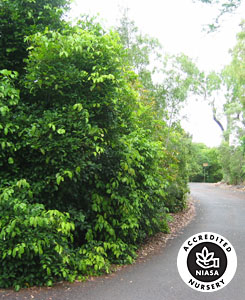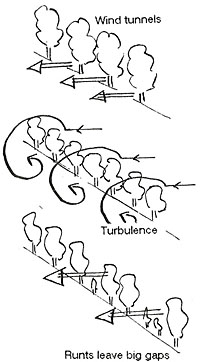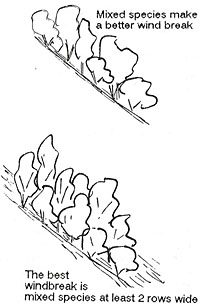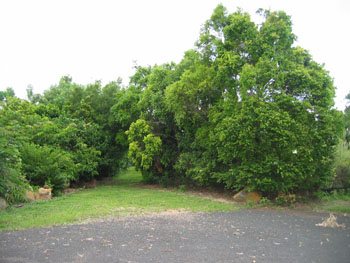Local North Queensland information for Local North Queenslanders.
 The best windbreak is one made up of a mixture of species, and at least 2 but preferably 3-5 plants wide…
The best windbreak is one made up of a mixture of species, and at least 2 but preferably 3-5 plants wide…
Contrary to popular belief, windbreaks made out of single row of a single species are not very effective.
The best windbreak is one made up of a mixture of species, and at least 2 but preferably 3-5 plants wide. Contrary to popular belief, windbreaks made of a single row of a single species are not very effective.
The case against single row/single species windbreaks
- Single species windbreaks:
Plants of the same species have leaves of the same shape and size, and grow to more or less the same shape and mature height. Therefore even gaps form amongst and between the plants, creating even tunnels for the wind to rush through. Even if they are planted close enough to merge they will form a barrier of even height. The wind is forced over the top in an even stream and turbulence may result on the leeward side. - Runts:
 In any batch of plants there are always one or two which do not grow as well as the others. In a single species planting, these runts stand out like a sore toe and look unsightly. Worse still, they create big gaps for the wind to tunnel through. This situation is difficult to remedy. Removing the runts and replacing them with new plants rarely works (unless done very early) since the new plants cannot compete with the vigorous and strong systems of the established plants on either side.
In any batch of plants there are always one or two which do not grow as well as the others. In a single species planting, these runts stand out like a sore toe and look unsightly. Worse still, they create big gaps for the wind to tunnel through. This situation is difficult to remedy. Removing the runts and replacing them with new plants rarely works (unless done very early) since the new plants cannot compete with the vigorous and strong systems of the established plants on either side. - Single row windbreaks:
Windbreaks consisting of a single row of plants such as Tallowwoods or Pines are not as effective as people believe. Such windbreaks may be reasonably good for the first few years while the trees are young and bushy (although Tallowwoods are brittle and not good windbreaks in their own right anyway), but eventually they grow into trees with trunks which allow the wind to tunnel through at the base almost unbroken. At this stage the owners want to remedy the situation by planting smaller bushy plants amongst the large trees. This does not work for two reasons:- Plants planted close to the base of existing big trees will not grow satisfactorily since they cannot compete with established root systems close by.
- Plants planted beneath big trees do not become bushy – instead they grow long and lanky as they stretch upwards for light.
The only cure for this situation is to rip the windbreak out and start again or plant a second windbreak about 10m behind the original one. From an aesthetic and environmental point of view, single species/single row windbreaks are a blot on the landscape. Rows of single species never occur in nature and are therefore jarring to the eye. Birds and other wildlife are rarely attracted to a single species situation, and monocultures are havens for pests.
The case for mixed species/multiple row windbreaks
- Shape & foliage:
 Different species have different shapes and different foliage. Therefore a windbreak consisting of mixed species planted at random has uneven gaps which break up the wind rather than allowing it to tunnel through.
Different species have different shapes and different foliage. Therefore a windbreak consisting of mixed species planted at random has uneven gaps which break up the wind rather than allowing it to tunnel through. - Height:
Different species grow to different heights. Therefore a mixed planting is uneven in height and the wind is broken up as it goes over the windbreak. Turbulence on the other side is therefore prevented. - Growth rate:
Different species grow at different rates. Therefore runts are less noticeable and are of little consequence to the effectiveness of the windbreak. - Windbreak width
Windbreaks should always be at least 2 rows of plants wide, preferably 3-5 rows. Even in a mixed planting there will be gaps in a single row which will allow tunnelling. If the plants are planted in two or more rows by zig-zagging or at random then wind that tunnels through the first row will be broken by the second or subsequent rows. - Aesthetics
Mixed plantings in multiple rows are aesthetically pleasing since the mixture of foliage types, shapes and colours, and of tree heights and shapes, blends into the natural landscape. While most windbreaks are a straight line for practical reasons, a multiple-row random planting reduces the jarring effect of the line. Birds and other wildlife are at home in mixed plantings, and their presence helps to control pests.
Enhancing air quality
Mixed plantings in multiple rows are a very effective way to enhance air quality since they act as:
- dust filters
- odour filters
- chemical filters
and in hot dry areas they also
- cool & humidify the air.
In addition they can improve groundwater quality by filtering pollutants from soil and groundwater.



